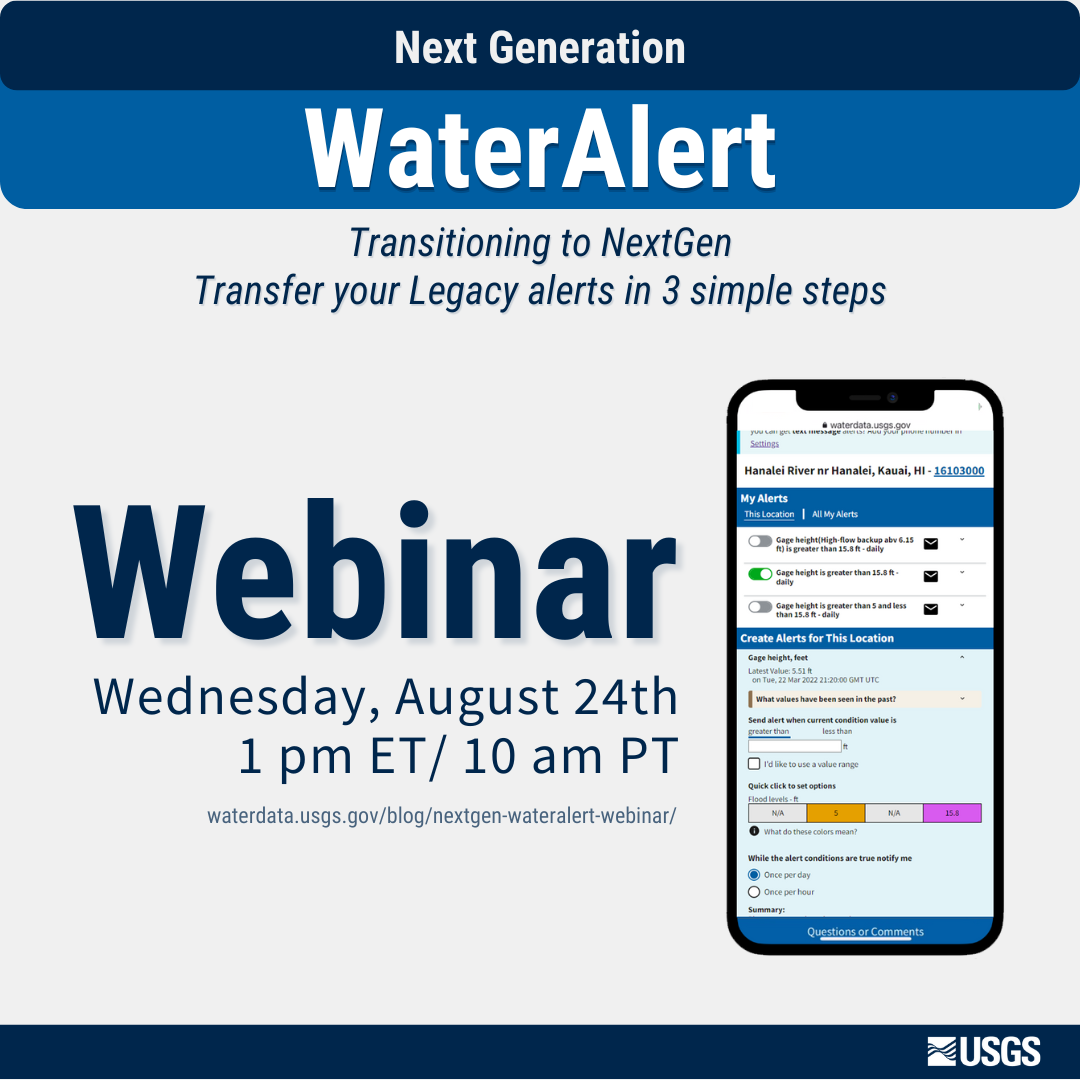Transitioning to NextGen WaterAlert | Webinar | Aug 24
In this webinar, learn how to transition your alerts to Next Generation WaterAlert.
Last updated July 29th, 2022 at 16:00 ET

During this webinar on August 24th at 1 pm ET/ 10 am PT about Next Generation WaterAlert, we will answer all your questions, facilitating the transition for Legacy WaterAlert users.
❔ What is this webinar about?
The United States Geological Survey monitors the waters of the nation. We display that data on Next Generation Monitoring Location Pages. But what if you don’t want to check the pages when your local stream floods? What if you want to be notified automatically? Good thing we have a service for that called WaterAlert!
WaterAlert is a popular subscription service that allows users to subscribe to email or text (SMS) messages when certain parameters, as measured by a USGS monitoring location, exceed user-definable thresholds. In essence, users select the type of data they need, like streamflow/discharge or gage height, and WaterAlert will send notifications once per hour or daily, whatever the user selects.
USGS is on a long-haul journey to modernize our water data delivery systems and WaterAlert is one of those data delivery systems. But in order for existing users to preserve their existing alerts in the Legacy system, they will have to take action. So in this webinar we’ll walk you through those steps to transition to the NextGen system, and we’ll answer any of your questions about WaterAlert.
Read more about the WaterAlert transition .
🕛 When is it?
Wednesday, August 24th, 2022 at 1 pm ET/ 10 am PT. We’re scheduling this event for immediately after the transition period opens so we can walk you through the transition.
This webinar will be recorded. We’ll post the recording about one week after the event on this blog post, on our WMA website , and on the USGS YouTube channel .
👩💻 Who is it for?
- Legacy WaterAlert users
- Anyone interested in learning more about WaterAlert
📆 How can I register?
We do not require registration to attend this open event, but for ease of adding this event to your calendar, you can fill out this form . Microsoft Power Automate will send you an email confirmation on our behalf with the link to join the webinar (link is also below). We’ve noticed that Gmail often directs these automated confirmation emails to spam - so be sure to check your spam folder!
📞 Where’s the link to join the live call?
Check back closer to the date of the webinar for the link to join the live call.
🎥 Recording
Check back about one week after the event and we’ll post the recording!
Related Posts
Transition to NextGen WaterAlert NOW
August 22, 2022
The transition opens today, August 22nd, 2022 and will close on September 30th, 2022. Date What Will Happen August 2022 Next Generation WaterAlert is available August 22nd, 2022 Transition period opens September 30th, 2022 Transition period closes October 1st, 2022 Legacy WaterAlert is Decomissioned 📩 Check your email!
Next Generation WaterAlert | Steps to Transition
April 11, 2022
See our most recent blog post on WaterAlert. Last updated July 29th, 2022 at 16:00 ET We're Modernizing WaterAlert Starting in summer* 2022, expect to hear from us by email or text about transitioning your legacy alerts to Next Generation WaterAlert , which will go live in fall* 2022.
NextGen WaterAlert is out!
October 18, 2022
Our team is pleased to announce that the transition from Legacy WaterAlert to NextGen WaterAlert is complete! Access NextGen WaterAlert now ! WaterAlert is a near real-time hydrologic alerting system.
Redirecting the Next Generation Monitoring Location Pages
October 14, 2022
During the week of October 17th, many links to legacy real-time pages will be redirected to the Next Generation monitoring location pages. This means that bookmarked links to the legacy real-time pages will be redirected automatically to the NextGen monitoring location pages.
WDFN Quarterly Newsletter
May 24, 2022
Did you know that we have a quarterly newsletter? Check out our latest edition! Screenshot of the beginning of our Spring 2022 WDFN Newsletter .

